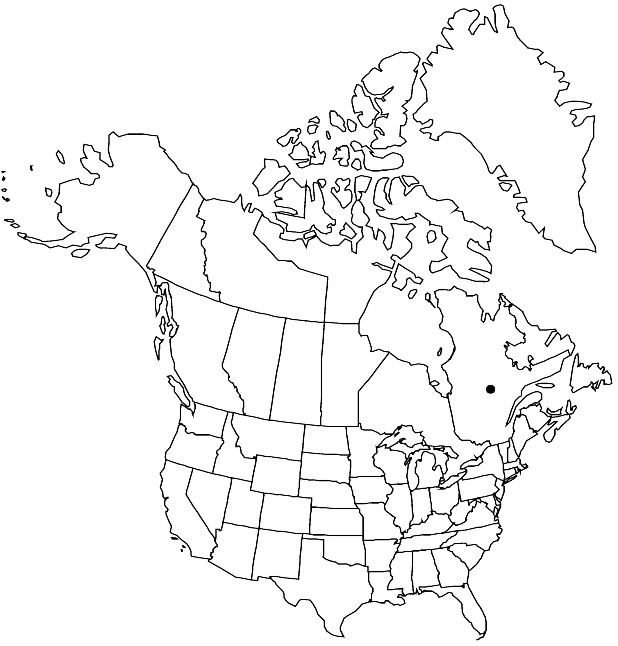Difference between revisions of "Salix chlorolepis"
Rhodora 7: 186. 1905.
FNA>Volume Importer |
imported>Volume Importer |
||
| (6 intermediate revisions by 2 users not shown) | |||
| Line 8: | Line 8: | ||
}} | }} | ||
|common_names=Green-bract willow | |common_names=Green-bract willow | ||
| + | |special_status={{Treatment/ID/Special_status | ||
| + | |code=E | ||
| + | |label=Endemic | ||
| + | }}{{Treatment/ID/Special_status | ||
| + | |code=C | ||
| + | |label=Conservation concern | ||
| + | }} | ||
|basionyms= | |basionyms= | ||
|synonyms= | |synonyms= | ||
| Line 25: | Line 32: | ||
|distribution=Que. | |distribution=Que. | ||
|discussion=<p>Of conservation concern.</p><!-- | |discussion=<p>Of conservation concern.</p><!-- | ||
| − | --><p>Salix chlorolepis, known from Mt. Albert, is characterized by its general glabrousness. It seems to have a relationship with S. brachycarpa similar to that of S. raupii to S. glauca. Both may have originated through mutation or hybridization.</p><!-- | + | --><p><i>Salix chlorolepis</i>, known from Mt. Albert, is characterized by its general glabrousness. It seems to have a relationship with <i>S. brachycarpa</i> similar to that of <i>S. raupii</i> to <i>S. glauca</i>. Both may have originated through mutation or hybridization.</p><!-- |
--><p>Hybrids:</p><!-- | --><p>Hybrids:</p><!-- | ||
| − | --><p>Salix chlorolepis forms natural hybrids with S. brachycarpa var. brachycarpa.</p><!-- | + | --><p><i>Salix chlorolepis</i> forms natural hybrids with <i>S. brachycarpa </i>var.<i> brachycarpa</i>.</p><!-- |
| − | --><p>Salix chlorolepis × S. pedicellaris is a putative hybrid that has relatively small, glabrous leaves. Both parents occur together on Mt. Albert, Quebec.</p> | + | --><p><i>Salix chlorolepis</i> × <i>S. pedicellaris</i> is a putative hybrid that has relatively small, glabrous leaves. Both parents occur together on Mt. Albert, Quebec.</p> |
|tables= | |tables= | ||
|references= | |references= | ||
| Line 37: | Line 44: | ||
-->{{#Taxon: | -->{{#Taxon: | ||
name=Salix chlorolepis | name=Salix chlorolepis | ||
| − | |||
|authority=Fernald | |authority=Fernald | ||
|rank=species | |rank=species | ||
| Line 51: | Line 57: | ||
|publication title=Rhodora | |publication title=Rhodora | ||
|publication year=1905 | |publication year=1905 | ||
| − | |special status= | + | |special status=Endemic;Conservation concern |
| − | |source xml=https:// | + | |source xml=https://bitbucket.org/aafc-mbb/fna-data-curation/src/2e0870ddd59836b60bcf96646a41e87ea5a5943a/coarse_grained_fna_xml/V7/V7_90.xml |
|genus=Salix | |genus=Salix | ||
|subgenus=Salix subg. Chamaetia | |subgenus=Salix subg. Chamaetia | ||
Latest revision as of 23:36, 5 November 2020
Plants 0.15–0.2 m, not clonal. Stems erect; branches red-brown, (weakly glaucous), glabrous; branchlets yellow-brown, glabrous. Leaves: stipules absent or rudimentary; petiole (deeply to shallowly grooved adaxially), 1–3.5 mm; largest medial blade elliptic, oblanceolate, or obovate, 14–33 × 7–12 mm, 1.9–3.4 times as long as wide, base cuneate or convex, margins flat or slightly revolute, entire, ciliate, apex acute, convex, or rounded, abaxial surface glabrous, adaxial slightly glossy, glabrous; proximal blade margins entire; juvenile blade (sometimes reddish), glabrous, ciliate. Catkins: staminate 6.5 × 5–8 mm, flowering branchlet 1–3 mm; pistillate densely flowered, stout or subglobose, 7–12 × 3–6 mm, flowering branchlet 1.8–12 mm; floral bract tawny, brown, or greenish, 1–2.6 mm, apex broadly rounded to retuse, entire, abaxially glabrous. Staminate flowers: abaxial nectary 0.3–0.4 mm, adaxial nectary oblong, 0.5–0.8 mm, nectaries distinct; filaments distinct, glabrous; anthers ellipsoid, 0.4–0.6 mm. Pistillate flowers: adaxial nectary narrowly oblong, 0.9–1.6 mm, longer than stipe, nectaries distinct or connate and shallowly cup-shaped; stipe 0–0.4 mm; ovary pyriform, glabrous, beak abruptly tapering to or slightly bulged below styles; ovules 8–10 per ovary; styles connate to distinct 1/2 their lengths, 0.5–1.3 mm; stigmas flat, abaxially non-papillate with rounded tip, or slenderly cylindrical, 0.3–0.6 mm. Capsules 3.6–6 mm. 2n = 38.
Phenology: Flowering Jul-early Aug.
Habitat: Wet Sphagnum bog on alpine, serpentine barrens
Elevation: 1000-1200 m
Discussion
Of conservation concern.
Salix chlorolepis, known from Mt. Albert, is characterized by its general glabrousness. It seems to have a relationship with S. brachycarpa similar to that of S. raupii to S. glauca. Both may have originated through mutation or hybridization.
Hybrids:
Salix chlorolepis forms natural hybrids with S. brachycarpa var. brachycarpa.
Salix chlorolepis × S. pedicellaris is a putative hybrid that has relatively small, glabrous leaves. Both parents occur together on Mt. Albert, Quebec.
Selected References
None.
